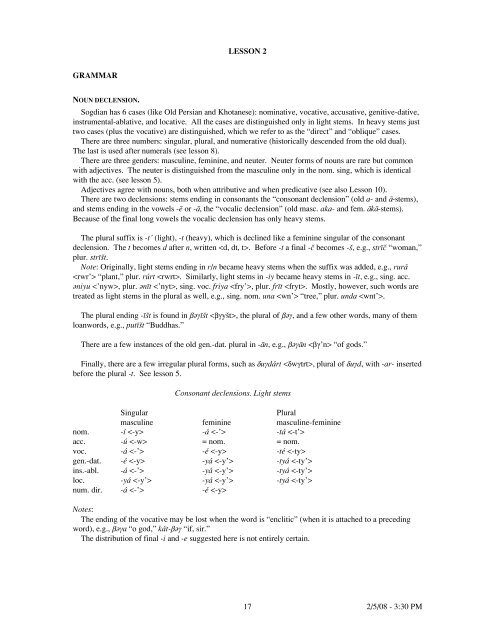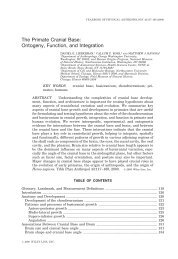17 2/5/08 - 3:30 PM LESSON 2 GRAMMAR Sogdian has 6 cases ...
17 2/5/08 - 3:30 PM LESSON 2 GRAMMAR Sogdian has 6 cases ...
17 2/5/08 - 3:30 PM LESSON 2 GRAMMAR Sogdian has 6 cases ...
Create successful ePaper yourself
Turn your PDF publications into a flip-book with our unique Google optimized e-Paper software.
<strong>GRAMMAR</strong><br />
NOUN DECLENSION.<br />
<strong>LESSON</strong> 2<br />
<strong>Sogdian</strong> <strong>has</strong> 6 <strong>cases</strong> (like Old Persian and Khotanese): nominative, vocative, accusative, genitive-dative,<br />
instrumental-ablative, and locative. All the <strong>cases</strong> are distinguished only in light stems. In heavy stems just<br />
two <strong>cases</strong> (plus the vocative) are distinguished, which we refer to as the “direct” and “oblique” <strong>cases</strong>.<br />
There are three numbers: singular, plural, and numerative (historically descended from the old dual).<br />
The last is used after numerals (see lesson 8).<br />
There are three genders: masculine, feminine, and neuter. Neuter forms of nouns are rare but common<br />
with adjectives. The neuter is distinguished from the masculine only in the nom. sing, which is identical<br />
with the acc. (see lesson 5).<br />
Adjectives agree with nouns, both when attributive and when predicative (see also Lesson 10).<br />
There are two declensions: stems ending in consonants the “consonant declension” (old a- and ā-stems),<br />
and stems ending in the vowels -ē or -ā, the “vocalic declension” (old masc. aka- and fem. ākā-stems).<br />
Because of the final long vowels the vocalic declension <strong>has</strong> only heavy stems.<br />
The plural suffix is -t’ (light), -t (heavy), which is declined like a feminine singular of the consonant<br />
declension. The t becomes d after n, written . Before -t a final -č becomes -š, e.g., strīč “woman,”<br />
plur. strīšt.<br />
Note: Originally, light stems ending in r/n became heavy stems when the suffix was added, e.g., rurá<br />
“plant,” plur. rúrt . Similarly, light stems in -iy became heavy stems in -īt, e.g., sing. acc.<br />
əniyu , plur. ənīt , sing. voc. friya , plur. frīt . Mostly, however, such words are<br />
treated as light stems in the plural as well, e.g., sing. nom. una “tree,” plur. unda .<br />
The plural ending -īšt is found in βəγīšt , the plural of βəγ, and a few other words, many of them<br />
loanwords, e.g., putīšt “Budd<strong>has</strong>.”<br />
There are a few instances of the old gen.-dat. plural in -ān, e.g., βəγān “of gods.”<br />
Finally, there are a few irregular plural forms, such as δuγdárt , plural of δuγd, with -ar- inserted<br />
before the plural -t. See lesson 5.<br />
Consonant declensions. Light stems<br />
Singular Plural<br />
masculine feminine masculine-feminine<br />
nom. -í -á -tá <br />
acc. -ú = nom. = nom.<br />
voc. -á -é -té <br />
gen.-dat. -é -yá -tyá <br />
ins.-abl. -á -yá -tyá <br />
loc. -yá -yá -tyá <br />
num. dir. -á -é <br />
Notes:<br />
The ending of the vocative may be lost when the word is “enclitic” (when it is attached to a preceding<br />
word), e.g., βəγa “o god,” kát-βəγ “if, sir.”<br />
The distribution of final -i and -e suggested here is not entirely certain.<br />
<strong>17</strong> 2/5/<strong>08</strong> - 3:<strong>30</strong> <strong>PM</strong>
AN INTRODUCTION TO MANICHEAN SOGDIAN<br />
Consonant declensions. Heavy stems<br />
Singular Plural<br />
masculine feminine masculine-feminine<br />
dir. - - -t <br />
voc. -, -a *-e *-te<br />
obl. -ī -ī -tī <br />
numerative - -, -é <br />
Note: The vocative ending -a is borrowed from the light stems.<br />
Vocalic declensions<br />
Singular Plural<br />
masculine feminine masculine feminine<br />
dir. -ē -ā -ēt -ēt <br />
voc. -ā ? ? ?<br />
obl. -ē -ē -ētī -ētī <br />
Numerative -ē <br />
Notes:<br />
The endings of this declension are the result of vowel contractions after the loss of an intervocalic k, e.g.,<br />
sing. nom. masc. -ē
<strong>LESSON</strong> 2<br />
Consonant declensions. Heavy stems<br />
Singular<br />
masculine feminine<br />
dir. mēѳ žəwān <br />
voc. martiya strīče <br />
obl. mēѳī žəwānī <br />
Numerative mēѳ žəwān , žəwāne <br />
Plural<br />
masculine feminine<br />
dir. mēѳət žəwānd <br />
voc. martīte δuγdárte <br />
obl. mēѳtī žəwāndī <br />
The actual pronunciation of the forms of stems such as martiy/martī “man” is not know, but it is<br />
probable that the sing. obl. was contracted: martiyī/martī’ī > martī.<br />
Vocalic declensions<br />
Singular<br />
masculine feminine<br />
dir. murtē xānā <br />
voc. murtā ?<br />
obl. murtē xānē <br />
Numerative murtē <br />
Plural<br />
masculine feminine<br />
dir. murtēt xānēt <br />
voc. ? ?<br />
obl. murtētī xānētī <br />
Note: The abstract fem. nouns in -yā are usually invariable, but occasionally the ending -ī (-yī) of the obl.<br />
sing. may be attached to the nom. of such nouns, e.g., ək ə tyā “act, deed,” obl. əktyāyī ; γərβākyā<br />
“knowledge,” obl. γərβākyā’ī .<br />
PRONOUNS. THE DEFINITE ARTICLE.<br />
The most common pronoun is xō (xu) “that,” which also functions as definite article. The forms below<br />
are those of xō when used as the article. For the pronoun “that” see lesson 4.<br />
We do not know what the quantity of the final vowels were: xō or xu; xā or xa, etc. In <strong>Sogdian</strong> script the<br />
article is ’xw or ’x, which perhaps points to a short vowel.<br />
Note that, since the plural of nouns is formally a feminine singular, the plural of the article is identical<br />
with the feminine singular.<br />
The forms in square brackets are found occasionally.<br />
masc. fem. = plur. masc.-fem.<br />
Sing.<br />
nom. xō xā [xō ]<br />
acc. (ə)wu [xō ] wa [xā , wu ]<br />
gen.-dat. uné, winé uya , wī <br />
instr.-abl. -n , -wn uné, winé , -n , -wn <br />
loc. uya , wī = gen.-dat.<br />
19 2/5/<strong>08</strong> - 3:<strong>30</strong> <strong>PM</strong>
AN INTRODUCTION TO MANICHEAN SOGDIAN<br />
Note the combinations pər + əwu: pərō “on the” and kə + əwu: kū “to the” which are used<br />
for both masculine and feminine, singular and plural.<br />
The instr.-abl. forms are found only combined with the prepositions čə “from” and δə “with”: čən, čōn<br />
and δən, δōn .<br />
Notes.<br />
There is no indefinite article.<br />
Adjectives agree with their nouns in gender and number.<br />
Word order: article + adjective + noun.<br />
NOUN CLAUSES.<br />
In a clause consisting of a noun plus predicate noun or an adjective, e.g., “the people (is) happy,” the verb<br />
“is” (əsti , xəčí ) and “are” (xand ) are sometimes, but not usually, omitted. The<br />
negation is nēst “is not.”<br />
Notes.<br />
TEXT 2<br />
xō rəmi šātux əsti, xā rəmta šātuxt xand dnx txwtaπ a†mr ax . ytsa xwtaπ ymr wx<br />
xā δēw ə t šātuxt nē xand dnx yyn txwtaπ twyl ax<br />
xō Rəxši əspi əsti yytsa yypsa yπxr wx<br />
xō pətəri məzēx martiy əsti yytsa y†rm xyzm yyr†p wx<br />
xō mēѳ ruxš ə ni xəči y⋲x yynπxwr lym wx<br />
xā mēѳ ə t ruxšənda xand Dnx adnπxwr tl£ym ax<br />
xā una əskēčīk əsti eytsa Qycyksa enw ax<br />
xā unda əskēčīk ə t xand Dnx tqycyksa ednw ax<br />
xā xānā məzēx ə č xəči y⋲x ecxyzm eanax ax<br />
xō martiy məzēx nēst †syyn xyzm yy†rm wx<br />
; dnykrwaz yta tdnpsalrm yta ty†πyrf ttπy©∫ eadnπxwr ax<br />
<br />
1. rəmtá is nom.-acc. plur. light stem noun, šā́tuxt is nom.-acc. plur. heavy stem adjective, xā is the the<br />
definite article nom. sing. agreeing with rəmta.<br />
1. Write out the noun paradigms in Manichean script.<br />
EXERCISES 2<br />
2. Write out the paradigms of the following words in transliteration and transcription: πxr Rəxš, Nryz<br />
zérən, both masculine, and klp pəδk and kra árk, both feminine.<br />
3. Identify the forms below and write out the other case forms (nom., acc., gen.-dat., and loc.) with the<br />
definite article:<br />
dnwalpyx wx yyxrp wwx<br />
yy†rm wx ranyl wts ww<br />
w©∫ wwa yy©∫awrz ynw<br />
anax ax ykra ayw<br />
2/5/<strong>08</strong> - 3:<strong>30</strong> <strong>PM</strong> 20
<strong>LESSON</strong> 2<br />
4. Translate into <strong>Sogdian</strong> and write in Manichean script:<br />
The other Budd<strong>has</strong>.<br />
The man is a great lord.<br />
Life (the life) is good.<br />
The angels are light.<br />
The elements are not happy.<br />
GLOSSARY 2<br />
’kty’ əkətyā/əktəyā: act, deed<br />
’ny əniy: other<br />
’rk ark fem.: work<br />
’skycyk əskēčīk: high, tall<br />
’ty əti: and<br />
βγ, plur. βγyšt, βγ’n βəγ, βəγīšt, βəγān: lord, sir<br />
δwγt, plur. δwγtrt δuγd, δuγdárt fem.: daughter<br />
δyw δēw: demon<br />
γrβ’ky’ γərβākyā: knowledge<br />
fry friy: dear<br />
jw’n žəwān fem.: life<br />
kt kát: that, if<br />
mrδ’spnd mərѳāspənd: element, the sons of Primal Man (Xorməzd)<br />
mwrty murtē: corpse<br />
mzyx, fem. mzyxc məzēx, məzēxč: big, great<br />
ny nē: not<br />
pδk pəδk fem.: judgement<br />
prxy pərxē: payment, wages<br />
ps’k pəsāk fem.: wreath, crown<br />
pwt, plur. pwtyšt put (bud), putīšt: Buddha<br />
rm rəm: people<br />
rwxšn ruxšən: light (adjective)<br />
rwxšn’γrδmn ruxšna-γərəδmən fem.: the Light Paradise<br />
rxš Rəxš: name of Rustam’s horse<br />
stryc, plur. stryšt strīč, strīšt: female, woman<br />
sy’k səyāk fem.: shade, shadow<br />
šyr šir: good<br />
šyr’k širāk fem.: goodness<br />
wyn’ wīnā fem.: lute, viṇā<br />
xypδ’wnd xēpѳāwənd: master, lord, owner<br />
z’wrkyn zāwərkēn: powerful<br />
21 2/5/<strong>08</strong> - 3:<strong>30</strong> <strong>PM</strong>
AN INTRODUCTION TO MANICHEAN SOGDIAN<br />
2/5/<strong>08</strong> - 3:<strong>30</strong> <strong>PM</strong> 22

















